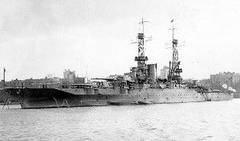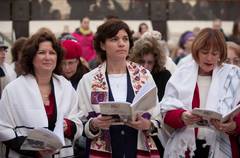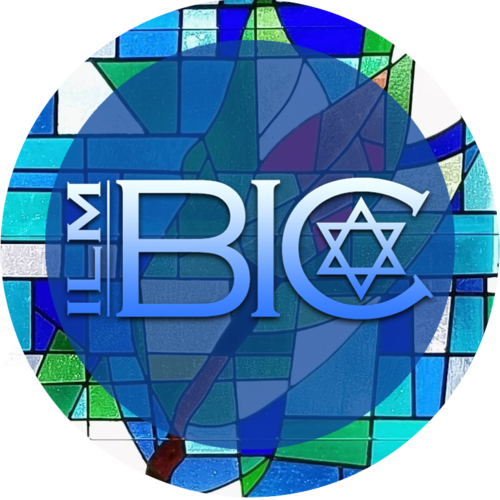History
The Early Years
 The history of the Bnai Israel Congregation began with the arrival of Eastern European Jews in Wilmington NC in the 1890s. These immigrants had landed on Ellis Island and traveled south to find opportunities for themselves and their families. On January 6, 1898, ten of these men, feeling the need for an organized Jewish community, met in a private home and founded the B’nai Israel Society. From this root, the present Bnai Israel Congregation developed.
The history of the Bnai Israel Congregation began with the arrival of Eastern European Jews in Wilmington NC in the 1890s. These immigrants had landed on Ellis Island and traveled south to find opportunities for themselves and their families. On January 6, 1898, ten of these men, feeling the need for an organized Jewish community, met in a private home and founded the B’nai Israel Society. From this root, the present Bnai Israel Congregation developed.
The January 18, 1898 issue of the Wilmington Morning Star newspaper reported: “B’nai Israel Society Formed. The B’nai Israel Society of Wilmington, which yesterday became incorporated by the Secretary of State, has been formed to be a benevolent, religious and charitable institution and to be a non-profit organization. Its purposes will be to erect a house of worship, to establish and maintain schools, to aid its members in distress. and to provide a suitable place of burial for its dead.”
The Society’s first order of business, almost immediately after its founding, was to begin searching for a cemetery site. On January 21, 1898, B'nai Israel Society purchased a tract of land southeast of Bellevue Cemetery and began the process of converting it into a Hebrew Cemetery. Nathan Stein managed the designation and location of family plots. He also chaired the Chevrah Kaddisha Committee, which prepares men’s bodies for burial according to Jewish rituals. His son Stephen Stein has assumed many of these duties to this day.
The January 21, 1898 issue of the Wilmington Morning Star reported that B’nai Israel Society’s first officers had been elected and arrangements “for the purchase of lands suitable for the purposes … to start a cemetery” had begun.
Breaking Ground
By 1911, the congregation had decided to build an Orthodox synagogue, the first one in Wilmington. A building committee purchased property at 313 Walnut Street to construct Bnai Israel Synagogue. The cornerstone of the synagogue was laid in 1913. In fact, this very cornerstone was salvaged when the Walnut Street building was torn down and is now in the minyan room of our current Chestnut Street location.
At the Walnut Street synagogue, services were conducted almost entirely in Hebrew. Women sat in the balcony. There was a mikvah (ritual bath) in the basement. Most members lived in close proximity to the synagogue and walked to Sabbath services.
In the 1920s the Sisterhood was founded. At first, the organization was called the Jewish Women’s Benevolent Society. They undertook many social and educational activities in the congregation.
World War II Era
World War II had a significant impact on the local Jewish community. Camp Davis, Camp Lejeune, and Bluethenthal Field were major military bases nearby . Wilmington became an important training area for soldiers, airmen and marines, and the city’s Jewry hosted many service personnel with home-cooked meals. Some of these soldiers became sons-in-law to Wilmington Jewish families.
. Wilmington became an important training area for soldiers, airmen and marines, and the city’s Jewry hosted many service personnel with home-cooked meals. Some of these soldiers became sons-in-law to Wilmington Jewish families.
Many of these families stayed in Wilmington after World War II. Soon, the congregation felt the need for larger quarters.
The New Building
The Congregation obtained the property at the corner of 26th St and Chestnut St. Ground was broken in November 1953 and the new building was completed in September, 1954.
 Rabbi Samuel Friedman joined the congregation near the end of the war. He remained as spiritual leader of Bnai Israel from 1944-1965. During Rabbi Friedman’s tenure, Bnai Israel Congregation continued to grow. Members were joining the Congregation from surrounding communities such as Burgaw, Wallace, Warsaw, Jacksonville, Whiteville, Elizabethtown, and Tabor City.
Rabbi Samuel Friedman joined the congregation near the end of the war. He remained as spiritual leader of Bnai Israel from 1944-1965. During Rabbi Friedman’s tenure, Bnai Israel Congregation continued to grow. Members were joining the Congregation from surrounding communities such as Burgaw, Wallace, Warsaw, Jacksonville, Whiteville, Elizabethtown, and Tabor City.
Throughout this period, the Sisterhood was a strong force in the life of the Congregation. The Sisterhood organized rummage sales and bake sales to raise funds to equip and run the kitchen, which was at the center of the Congregation’s religious and social activities.
The move to the new synagogue in 1954 involved more than just a change of physical environment. It brought changes in the ritual practices of the membership. The new synagogue brought the end of separate seating for men and women. In a gesture of respect to some traditional members, the first row of seats across the front of the sanctuary were reserved for men only. Moreover, the new synagogue did not have a mikvah.
Enter Conservative Judaism
The synagogue revised its constitution in 1957, declaring its philosophical affiliation with the Conservative movement. Much later, from 1973 through 1981, the synagogue was a dues-paying member of the United Synagogue of America, the national organization of Conservative Synagogues.
Beginning in the 1950s, the congregation began to offer women more opportunities to participate in rituals and services. For the first time, girls began to train for the Bat Mitzvah. The first female teenagers celebrated their B'not Mitzvah as part of a Friday Sabbath evening service on August 21, 1955.
In 1962 the members of the congregation paid off the mortgage and celebrated its burning. In the period from 1962-1964, the congregation undertook a major remodeling of the pulpit area.
In the years after Rabbi Friedman’s departure, the tenure of succeeding rabbis was short as the congregation struggled to define and reconcile their differing spiritual needs. During periods when the congregation was without a rabbi, various lay-people assumed responsibility for a rabbi’s normal duties.
Egalitarianism
By the middle of the 1970s and into the early 1980s, Wilmington's next generation of Jews were joined by an influx of newcomers, brought to town by the industries being established here. Together they continued the work of the synagogue. Additionally, in 1974 the congregation’s constitution was amended to allow women to join as individuals.
 Increasingly during the 1970s, the Sisterhood presidents became involved in the governance of the synagogue, and were permitted to attend the synagogue board meetings. In the latter part of the decade, the Sisterhood presidents served as full members of the Board.
Increasingly during the 1970s, the Sisterhood presidents became involved in the governance of the synagogue, and were permitted to attend the synagogue board meetings. In the latter part of the decade, the Sisterhood presidents served as full members of the Board.
In July 1981, S. Robert Waxman began his tenure as rabbi. As a young man with progressive attitudes and values, he reflected the desire of the congregation for a spiritual leader who was American-born, good with children, and able to add meaningful elements to the worship services. His wife Barbara was an English professor at UNCW and an author.
Women began taking more active roles in Shabbat and holiday services, conducting a Sisterhood Sabbath Evening service and participating in an “E-Service” (egalitarian Sabbath morning service), which was established to enable women to participate in the davening.
In the mid-80s, the egalitarian Bat Mitzvah became another option for families with daughters. An egalitarian service with participation by women was held when the Torah was read at the Shabbat mincha (afternoon) service. Today, Bnai Israel has fully egalitarian Shabbat and Holiday services, and since 1990, egalitarian bnot mitzvah and bnai mitzvah celebrations.
Expansion
In 1990, a major fundraising campaign was initiated for the renovation of the synagogue. The Block Auditorium and the classrooms were redone. A sukkah that would accommodate about 40 individuals for kiddush was built. The kitchen was renovated, and in recognition of the hundreds of meals Edith Alper prepared there for synagogue, UJA, and Hadassah events, a plaque with the inscription “Edith Alper’s Kitchen,” was mounted at the entrance to the kitchen. The classroom addition was completed on December 6, 1995.
The 21st century has seen more changes and advances. The sanctuary and social hall were renovated thanks to a major bequest from the estate of Jerome Shain. Gorgeous stained-glass windows designed by a local artist were installed in the sanctuary and in the minyan room thanks to a generous group of congregants. Outside the sukkah has been expanded and the installation of a Meditation Garden is at hand. The cemetery is also being expanded thanks to a gift of land for approximately 250 more gravesites donated by Irv Freedland and Walter Pancoe. The sanctuary was totally renovated in 2020 due to a water intrusion that was topped off by Hurricane Florence.
Changing of the Guard
In June of 2015, Rabbi Robert Waxman retired and was appointed Rabbi Emeritus. The congregation celebrated his 34 years of service at a dinner in Landfall in May 2013 and at a farewell party at the synagogue in May 2015. Rabbi Waxman continues to participate in services and is very involved in the music of Bnai Israel. We are blessed to still have his talent and wisdom!
Rabbi Julie Kozlow joined the Bnai Israel Congregation in June, 2015. She brought her own energy and passion to the synagogue, implementing new and exciting programs. Her tenure ended in July 2019 when she moved to be closer to her family in California.
Rabbi Barry Kenter served as Interim rabbi from September 2019 to June 2020 while the search for a new permanent religious leader was conducted. He brought his many years of experience from leading his New York congregation for more than 30 years. Additionally, his post-retirement position as interim rabbi for several other congregations helped us immensely during this period of transition.
Rabbi Chaya Bender joined us on July 1, 2020 when she moved from Connecticut to become our permanent rabbi in the midst of the Covid-19 pandemic. We are so thrilled to have such an enthusiastic and energetic rabbi! She immediately restarted weekly services and weekly Adult Education programs, both via Zoom. Camp Mensch keeps the children and (even some adults) engaged virtually on Sunday mornings. We are looking forward to a very exciting year with her!
History of Bnai Israel in Photos*
* We would love to hear from you if you have any photos of the old building or the sanctuary pre-renovation that you would like to share!
Sat, November 15 2025
24 Cheshvan 5786
_____
SHABBAT
Friday evening service
6:00 pm
Saturday morning service
9:30 am
All services on Livestream and
in-person.
Questions about membership?
BIC Weekly Newsletter
Congregational Meeting November 14, 2025 4 PM
Save the Date: 5th Annual International Joy of Art Show and Sale
Bnai Israel Congregation - 2601 Chestnut St - Wilmington, NC 28405 - (910) 762-1117
Mailing Address - PO Box 7104 - Wilmington, NC 28406-7104
FIND US ON SOCIAL MEDIA:
 Follow Us on Facebook -
Follow Us on Facebook -  Follow Us on Instagram -
Follow Us on Instagram -  Subscribe to our YouTube Channel
Subscribe to our YouTube Channel
Click on the icons below to find out more about what it means at Bnai Israel
Privacy Settings | Privacy Policy | Member Terms
©2025 All rights reserved. Find out more about ShulCloud




